Continent accounted for nearly half the world’s Covid-19 deaths in past two weeks; millions falling back into poverty
By Luciana Magalhaes and Juan Forero
Rio de Janeiro’s densely populated favelas like Rocinha are among the communities hardest hit by the coronavirus. Leonardo Carrato for The Wall Street Journal
RIO DE JANEIRO—In early May, the new coronavirus swept through the crowded homes in Alley 24 of Rocinha, one of the largest of Brazil’s favelas, or slum communities.
Twenty of the 35 members of Ivanete Dias de Carvalho’s extended family who live crammed together here came down with symptoms of Covid-19, from high fevers to fluid-filled lungs. Few were able to get a test. Her 65-year-old aunt died.
And the disease rolls on. Across Rio, the official number of deaths is approaching 6,000. For Brazil, with a population of 210 million, that number is more than 51,000, with 1.1 million people infected—a toll second only to the U.S. The real tally of dead is almost certainly much higher, public-health experts say.

Ivanete Dias de Carvalho’s extended family live in Rocinha, one of Brazil’s biggest favelas. Twenty of the 35 members of her extended family came down with Covid-19 symptoms.
Photo: Leonardo Carrato for The Wall Street Journal .
 Her 65-year-old aunt, Sonia, died last month after showing symptoms consistent with Covid-19. / Photo: Leonardo Carrato for The Wall Street Journal
Her 65-year-old aunt, Sonia, died last month after showing symptoms consistent with Covid-19. / Photo: Leonardo Carrato for The Wall Street Journal Latin America is the grim new center of the pandemic, with more than two million people infected and 100,000 deaths. The region, with more than 30 countries from the Rio Grande in the north to Tierra del Fuego in the south, has 8% of the world’s population, but accounted for 47% of coronavirus deaths recorded in the past two weeks.
Infectious-disease experts fear Latin America is a harbinger of things to come in India and other developing countries, as deaths decline in much of the developed world. The pandemic is also taking a huge toll on the economies of poorer nations, sending poverty rates skyrocketing and eroding the social gains made in the past two decades, particularly in regions like Latin America.
Mexico’s antipoverty agency predicts up to 10 million people will have fallen into poverty by the end of June, and in Peru the figure will likely be 2.5 million by year’s end, says the country’s central bank.
The coronavirus preys on the weaknesses in many poorer countries. It spreads rapidly in densely packed neighborhoods where hygiene is a challenge. People working as day laborers and in the informal sector can’t stay home if they want to feed their families.
On top of that, in Latin America, there is widespread distrust of the government, which has led many people to doubt official warnings about the dangers of Covid-19 and avoid hospitals. And unlike some rich countries, testing is spotty and hospital care is uneven and difficult to access. Mexico tests the least of any major nation, with just 3.3 tests per 1,000 people, Colombia is at 12.2 and Argentina is at 6.5, according to Our World in Data. In the U.S., the figure is 83.
Governments are reeling as they face the challenges of the pandemic with limited resources, while being pressured by millions of people and businesses to abandon lockdowns and reopen economies.
Lenin Moreno, president of hard-hit Ecuador, said the ravages of the disease have been worse than war. “In a war you can flee somewhere else,” he said in a videoconference call with The Wall Street Journal. “Here, you can’t flee anywhere.”
Workers bury a victim of Covid-19 at San Efren Municipal Cemetery in Ecatepec de Morelos, on the outskirts of Mexico City, on Friday. / Henry Romero/Reuters

A municipal worker disinfects a trolleybus in northern Quito, Ecuador, on June 3. / RODRIGO BUENDIA/AFP/Getty Images
People lined up to receive government aid in Puno, Peru, on Thursday. / CARLOS MAMANI/AFP/Getty Images

The number of Covid-19 cases are rising so fast in Chile that hospitals and their intensive-care units are strained. A morgue in Santiago, Chile, on Monday. / MARTIN BERNETTI/AFP/Getty Images
The disease has walloped Latin America’s two giants, Brazil and Mexico. Both are led by presidents—Jair Bolsonaro in Brazil and Andrés Manuel López Obrador in Mexico—who have played down the dangers of the virus, been skeptical of scientific advice and pushed for economies to reopen.
Health experts say their laid-back approach has confused citizens, with some sticking to self-isolation measures while others go about life as if there were no pandemic.
“In Brazil and Mexico there was an executive decision to not control this,” said Irene Bosch, an MIT scientist who does work in Latin America for the Atlanta-based Centers for Disease Control and Prevention. “You end up getting yourself in a situation where nothing works to control the pandemic. The result is death.”
Mr. Bolsonaro has defended his approach, saying that lives are priceless but that the economy and employment must return to normal. Mexico’s president has repeatedly said his government managed to “tame the pandemic.”
Here in Rocinha, where 100,000 people live in cinder-block dwellings packed on steep hillsides, the homes are small and many residents are heavily dependent on a day’s wages. Many working-age people can’t shelter inside.
Ms. de Carvalho, whose aunt died, said she had worried for months that if the virus came to Rocinha, she and her relatives would be defenseless. “I was neurotic, I was telling everyone, ‘Take care,’” said Ms. de Carvalho, 36, who started using a mask before others in her family.
“People thought I was going crazy.”
Elizabete Gomes da Silva, 55, a mother of six and a member of the extended Dias clan, now does what she can, like constantly cleaning her home on Alley 24. But she holds no illusions.
“In the communities, we always pay a higher price for everything,” she said, speaking of her favela. “There’s a chance everyone here is going to get sick.”
Brazil regularly logs more than 1,000 deaths on any given day. In the past week, it averaged 31,000 positive results a day for Covid-19 tests, according to government figures—about twice the level of any country except the U.S. at its peak.
Projections by various Brazilian universities estimate the country is on track to overtake the U.S. in total deaths sometime over the summer. The University of Washington in the U.S. projects 165,960 deaths in Brazil by early August, compared with 145,728 for the U.S.
Mexico, with more than 22,000 deaths, is seeing the disease rip through towns on the country’s border with the U.S., where hundreds of thousands of factory workers returned to their jobs after voluntary lockdowns were lifted at the start of June.
The city of Mexicali, which has roughly 700,000 people and is home to American plants, has 3,826 confirmed cases and 664 deaths from Covid-19 and is experiencing what health officials call a “period of intensive transmission.” Mexicali’s general hospital is at 92% of capacity, according to the state of Baja California Health Department.
“Returning comes with a certain amount of worry, because you don’t want to make a mistake and put yourself or your family at risk of infection,” said Martín Estupiñan, 44, who supervises a team of workers at one plant. But he said that workers also need their jobs and have to “learn to live with the disease.”
In Mexico, people are so wary of public health care that many families of Covid patients avoid taking them to the hospital until they are critically ill—at which point it is often too late, doctors say.

Elizabete Gomes da Silva, a member of the extended Dias clan, constantly cleans her home in the Rocinha favela but fears the virus will spread widely in her community. / Photo: Leonardo Carrato for The Wall Street Journal .
“I tell everyone I meet: Avoid the public hospitals,” said Jannete Rojas, whose father died in a public hospital with Covid-like symptoms. She reeled off a conspiracy theory she had heard, based on nothing more than hearsay, that hospitals are purposefully killing people.
“The people in my neighborhood all say it’s part of a global agreement to lower the population level,” she said, “especially of the poor, because governments can no longer afford to pay our pensions.”
Distrust also runs high in Peru, but that country’s government instituted a stringent lockdown and followed international protocol. It didn’t matter. People flocked to markets, creating dangerous clusters that spread. Peru now has more than 8,200 deaths and 257,000 cases, more than Italy and Spain.
There are success stories in the region. In Medellín, Colombia’s second-largest city, the mayor is using a smartphone app in which residents provide information to officials so they can more easily track and check the spread of the virus. Only seven have died.
Argentina, with 44 million people, has recorded fewer than 1,100 deaths, while Spain, only slightly larger in population, has more than 28,000. Health officials have feted tiny Uruguay and Costa Rica—both with well-functioning health systems and lower inequality than other countries—for their handling of the crisis.
But even in countries where overall numbers appear low, there are troubling spikes. That is particularly worrisome to health officials because while the pandemic isn’t under control, economies are reopening under pressure from the very people who are most vulnerable—those who work hand-to-mouth, usually without any kind of a social-safety net.

The Rio favela of Rocinha, foreground, is home to 100,000 residents who are heavily dependent on a day’s wages and can't shelter at home. / Photo: Leonardo Carrato for The Wall Street Journal .
“They tell us not to go out but how do we eat,” said María Herrara, who lives in the Chilean capital and whose husband works in a supermarket.
“I’m unemployed. My husband is the only one who works. And we’re afraid he could lose his job,” she said. “All the neighbors have coronavirus, many people do, but we are also afraid of hunger.”
Chile initially broke with convention in much of the region, holding off on a national lockdown. President Sebastian Piñera’s government instead carried out rolling quarantines by district, testing and reacting to outbreaks. But the caseload is rising so fast now that hospitals and their intensive-care units are strained.
Criticized for his handling of the crisis, the health minister, Jaime Manalich, recently resigned but not before telling his countrymen that the worst was yet to come.
“I dare say the stress on the health network will be greater,” he said. “And the pressure on the citizenry will be very, very severe to comply with the quarantine and the self-isolation measures.”
—Ryan Dube in Lima, Peru, and Robbie Whelan and David Luhnow in Mexico City contributed to this article.



0 comments:
Publicar un comentario